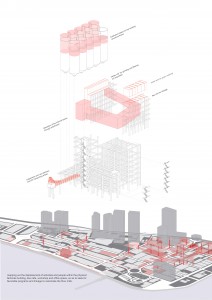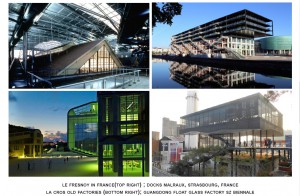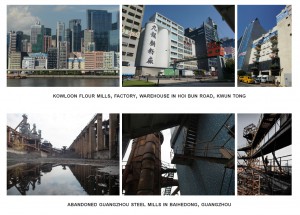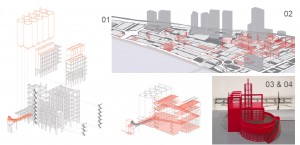|

My thesis will explore how new intervention can be integrated with and take advantage of the old to induce movement so as to repurpose the existing fabric with favourable identity. It aims at rethinking about the relations between movement and program in which architecture works as a trajectory of the changing cultural or economic forces within the urban fabric.
WHY?

With good intentions, architect tends to control people’s movement and the degree of interaction with the surrounding through alterations of existing fabric. In the past, Frank Lloyd Wright and Mies van der Rohe explored intensively how to induce movement via experiential effects created by superimposition and spatial orientation of planes and integration of materials. While the former employed the motion as a connector between man, architecture and pre-established site context, the later treated motion as a process of own spatial experience.
Currently, Bernard Tschumi explores the relations between movement, space and event in revitalizing the existing. Plugging new additions into the existing structure are adopted. Rem Koolhaas introduces a more top-down approach to alter or ignore the existing in terms of circulation and spatial organization. In Seattle central library, obsolete structure are removed and programmatic combinations serve as generator to restrict movement. Neither preservation nor removal of the entire existing would be the best solution in injecting new impetus into the old and keeping its own cultural and social values.
There is no architecture without movement. If no one utilizes the space, its identity and function change. Instead of an autonomous design regardless of existing context, my thesis will explore how new intervention can be integrated with and take advantage of the old, both original extrinsic tectonic system and intrinsic value, to induce new movements so as to repurpose the existing fabric with more favorable identity. It aims at rethinking about the relations between movement and program in which architecture works as a trajectory of the changing cultural or economic forces within the urban fabric.
WHAT?

The chosen sites are Kwun Tong in Hong Kong and Baihedong in Guangzhou, which have a prominent yet outdated identity as an industrial hub. Kowloon flour mills, old warehouses along the waterfront and abandoned Guangzhou steel mill near Zhujiang are potential test cases which have a strong cultural and historical value with their own unique tectonic system that restricts and regulates circulation for specific industrial production. The form and the structure follow specific function. However, due to rapid economic and social changes over time, their use value changes. In an architectural scale, the thesis is to explore how to transform or expand the existing structure and alter the circulation, attracting new supportive flows of people and events.
As Hong Kong has transformed from manufacturing-based economy to a service-oriented one, the use value and identity of factories in Kwun Tong deteriorates, causing displacements of factory workers and communities. Meanwhile, due to a national energy-efficiency campaign set up by the Guangzhou municipal government, old factories and power plants were forced to shut down and relocated and all workers left their factory apartments. Movement such as dislocation, dispersal or agglomeration is a result of economic and political changes. Resurgence of this forgotten industrial area could be a solution to reactivate the industry with introduction of new programs for a more sustainable development. With its close proximity to urban infrastructure and residential areas, it has a great potential for redevelopment.
HOW?

Thesis experiment 1.0:
Movement as a mode of analysis
Mapping out the circulation system of the existing industrial building directly framed by the structural system and spatial configuration through analytical drawing. Exploring new possibilities of such specific architectural qualities to adapt to alternative uses through 1:200 testing models in term of volumetric qualities.
Thesis experiment 2.0:
Movement as a trace of changes in urban space
a site analysis to find out the intangible forces that causes displacement of activities and people over time and seek for favorable programs that could potentially activate the obsolete fabric and regain the flow of events and people.
Movement as an initiator in alterations
1:200 / 1:100 testing models to investigate the integration of new structure into the existing via extension, subdivision or superimposition so as to fit new program with respective circulation.
Thesis experiment 3.0:
Synthesizing the thesis project
Exploration of intrinsic and extrinsic relationships of the altered structure through 1:100 plan and 1:200 section.
Analytical model of revised circulation system
1:100 / 1:50 partial model to test the circulation and program combinations, facade system and structural details
Thesis experiment 4.0:
Final development / Production
|